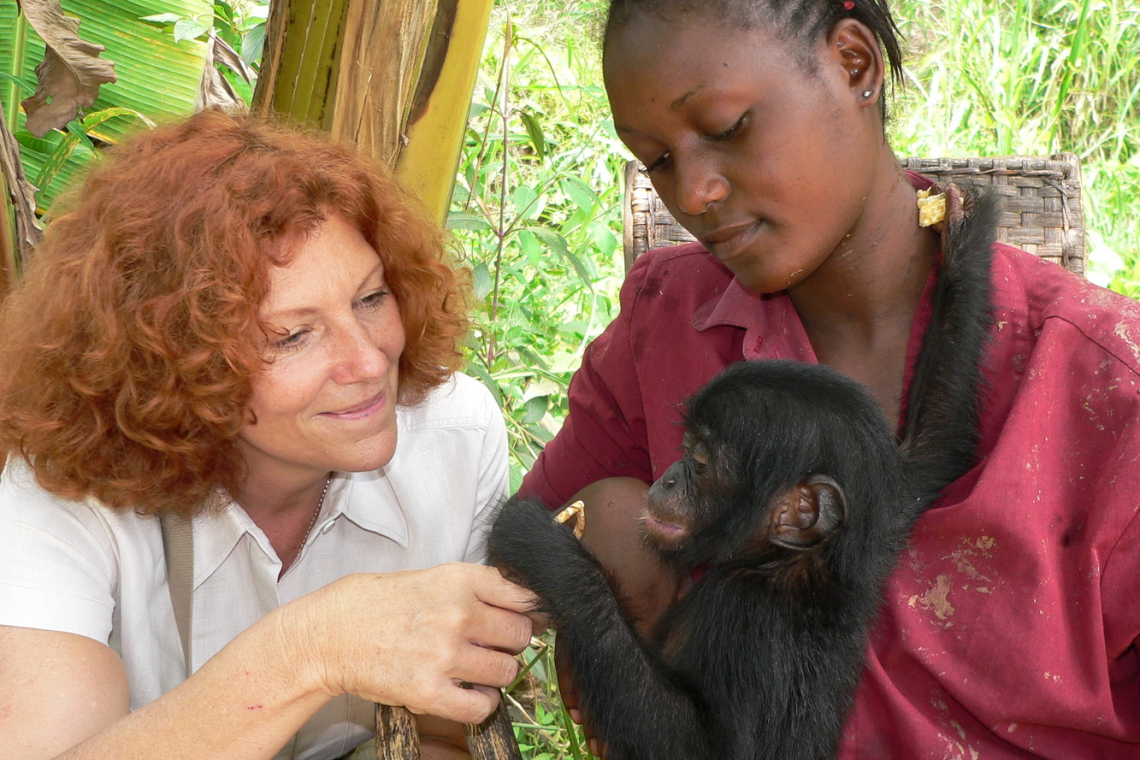First things first, you might be asking yourself ‘Funky name, but what on earth is a Bonobo?’.
Also known as the pygmy chimpanzee, bonobos are primates found in the Congo basin in Africa, and they also happen to be our closest living relatives alongside the chimpanzee. We share 98.7% of our DNA with Bonobos, meaning they are more closely related to us than they are to gorillas. That’s bonkers.
Bonobos are unique amongst not only primates, but the majority of mammals in the animal kingdom for their “make love not war” attitude, and putting the females in charge. Sadly, they’re also now endangered. The primary root causes are poverty, which drives people into illegal poaching, and habitat loss due to deforestation.

Mother and baby bonobo. Photo by Leon Haberkorn for Lola ya Bonobo.
I became curious to know more about what makes Bonobos so special and how we can go about saving our closest relatives. Therefore, I reached out to the world’s only Bonobo sanctuary, Lola Ya Bonobo, to find out more.
1. Please could you tell me about your role within the sanctuary and how you came to work for Lola ya Bonobo?
Hello, I’m Friends of Bonobos’ Executive Director Ariel Rogers. We are the US-based sister organization of Lola ya Bonobo, working closely with them to raise awareness for bonobos internationally. Lola ya Bonobo sanctuary is renowned for its work to rescue and protect endangered bonobos, but they do so much more, including rainforest protection, bonobo releases back to the wild, bonobo conservation in the wild, local education and awareness, and community development around wild bonobos.
Prior to coming to work for Friends of Bonobos, I led two other nonprofits focused on rainforest protection in the Democratic Republic of Congo and felt inspired by the animals that lived in the areas we were protecting, especially bonobos. My education and background in management, marketing, and nonprofit conservation work in the DR Congo paired with my lifelong passion for animal welfare made this the perfect role for me. I feel incredibly lucky to get to work on behalf of such an amazing species!
2. As the world’s only bonobo sanctuary, what inspired founder Claudine André to set it up?
In the mid 1980s, Claudine André was volunteering at the Kinshasa Zoo when a man brought in a sick baby bonobo. The zoo director warned her not to pour her heart into the little bonobo. Keeping bonobos was extremely difficult, and sick ones had not been known to survive. Yet, Claudine resolved to find a way to save the bonobo. She named him Mikeno.
With close attention and mothering, she was able to successfully rehabilitate the baby. The secret she had uncovered was that in addition to medical care and proper nutrition, baby bonobos need love and affection to survive. Word began to spread throughout the area and soon, people from all over were bringing orphaned baby bonobos to Claudine. This led her to found Amis des Bonobos du Congo (ABC) in 1994 and soon after created the sanctuary, Lola ya Bonobo. “Lola ya Bonobo” means Bonobo Paradise in Lingala, one of the national languages of the DR Congo. She and her team, now led by her daughter, Fanny Minesi, have been rescuing and rehabilitating bonobos ever since.
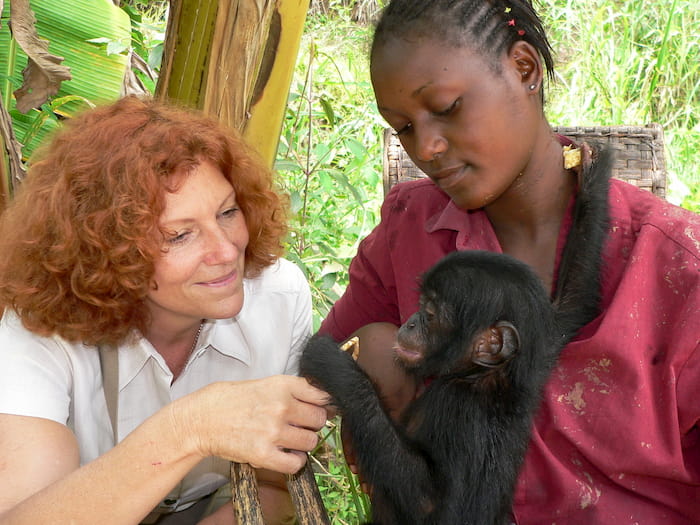
Claudine André alongside a young bonobo rescue and his surrogate mother. Photo: Lola ya Bonobo
3. Were there any challenges along the way? How did the team overcome these to make it the success it is today?
There were, and continue to be, severe challenges to saving bonobos. Bonobos are only found in one place in the entire world – the Democratic Republic of Congo – a country that has experienced war and political instability throughout much of its history. Widespread poverty is a main driver of poaching and the bushmeat trade that both threaten bonobos.
In addition, everything takes a lot of time due to limited infrastructure in the remote rainforests which makes navigation and access to electricity difficult.
Claudine always believed she could accomplish what she set her mind to – and she has. In my opinion, her success is largely due to her fierce ability to push through obstacles with incredible problem-solving and coalition-building skills. When she was told ‘no,’ which was very often, she just kept looking for the solution that was a ‘yes.’
4. What’s so special about bonobos? Why should we care about the protection of the species?
Bonobos are one of the most peaceful and cooperative species on the planet. They’re great at sharing and they’re welcoming to strangers. Bonobos resolve conflicts with love and affection. And bonobos don’t kill each other. They have a lot to teach humans!
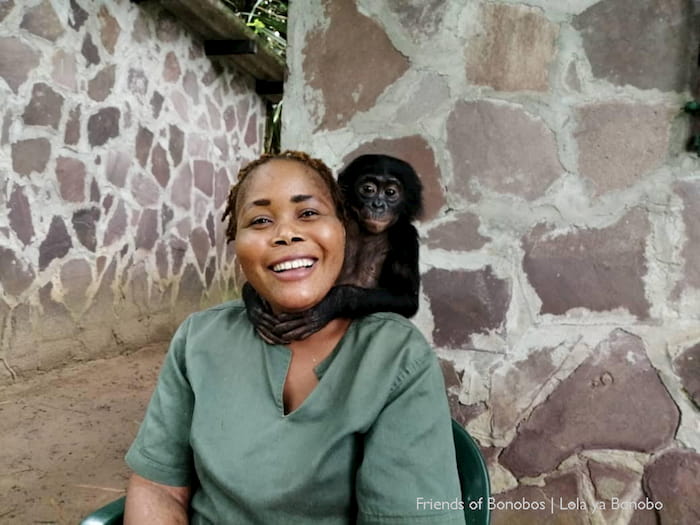
Mama S’arrive and baby bonobo, Tshimbulu. Photo: Lola ya Bonobo
Here are some of the things we know about bonobos:
- They are our closest living relatives. We are more closely related to bonobos (and chimpanzees) than we are to any other animal on earth. We share 98.7% of our DNA with bonobos – this means they are more closely related to us than they are to gorillas.
- Females are in charge. The main reason that bonobos are so peaceful is that they are matriarchal, which is unusual in the animal kingdom. The females work together to manage aggression in males.
- They’re peaceful and avoid conflict. Bonobos have evolved to avoid fighting, about anything. When the potential for conflict arises, chimpanzees experience a rise in testosterone, which is related to competitiveness, while bonobos experience a rise in cortisol, which is related to stress. This stress response leads bonobos to seek social reassurance. Over evolutionary time, bonobos have become much less aggressive than their ape relatives, including humans. There is no known case of a bonobo killing another bonobo. We cannot say the same thing about humans or chimpanzees!
- They’re good samaritans. Research shows that bonobos feel empathy not only towards those they know, but also those they don’t. When presented with the choice to share food, they preferred to share with strangers.
- Bonobos, both male and female, are known for their frequent use of socio-sexual contact to relieve tension and form bonds with one another.
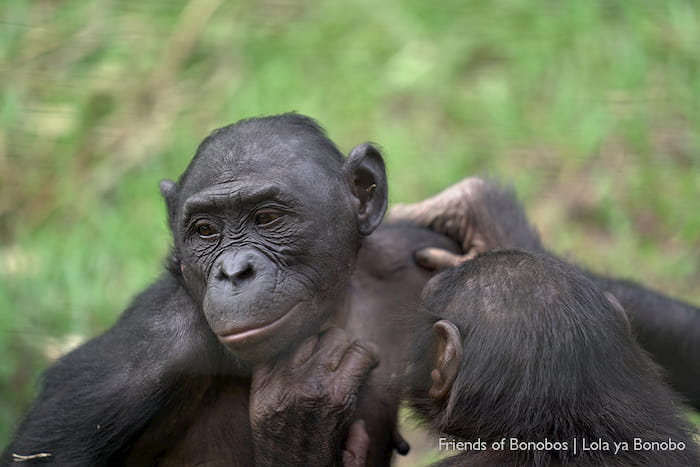
Bonobos grooming each other. Photo: Leon Haberkorn for Lola ya Bonobo
5. Bonobos are currently endangered partly due to the illegal bushmeat trade. However, are there any other threats facing the species such as deforestation?
Deforestation, commercial farming, and any other activity that destroys their rainforest habitat are problems threatening bonobo survival. For bonobos to thrive in the wild, access to suitable habitat is critical. That’s why Lola ya Bonobo has worked hard over the years to secure prime swamp rainforest. This is where we release bonobos who have been rehabilitated at Lola ya Bonobo. The release site, called Ekolo ya Bonobo Community Reserve, consists of 120,000 acres of protected rainforest managed in partnership with the neighboring communities and supported by the local and national government agencies. The reserve is patrolled by eco-guards who protect the bonobos from poachers.
However, poverty is the primary cause of poaching, so it’s vital that we address the underlying causes of extreme poverty in the Democratic Republic of the Congo if we are to reverse the course of bonobo extinction.
6. It is illegal to own, sell or kill bonobos, but it’s still happening far too often on the black market. What key factors will be paramount in changing behaviour and ending the trade?
Community development and awareness building are both crucial to changing behavior and ending the bushmeat trade. Extreme poverty is the main driver of poaching and bushmeat, which is why developing alternative sources of income is so important. Education and awareness building also play a large role in bonobo conservation.
Highlighting the uniqueness of bonobos and the biodiversity they add to the DRC promotes a sense of pride and responsibility among Congolese people, who then understand the urgency of working to conserve them.
Another key part of ending the black market is to stop the import from other countries. This requires stronger international laws and better enforcement of the laws that exist.
Basically, if there were no demand, there would be no need to kill bonobos!
7. Education and community involvement is such an important aspect of conservation. How is Lola ya Bonobo empowering communities to build a better future through conservation as opposed to the bushmeat trade?
The majority of staff members at both Lola ya Bonobo and Ekolo ya Bonobo are Congolese people. They occupy a range of positions including veterinarians, bonobo keepers, surrogate mothers, and eco-guards.
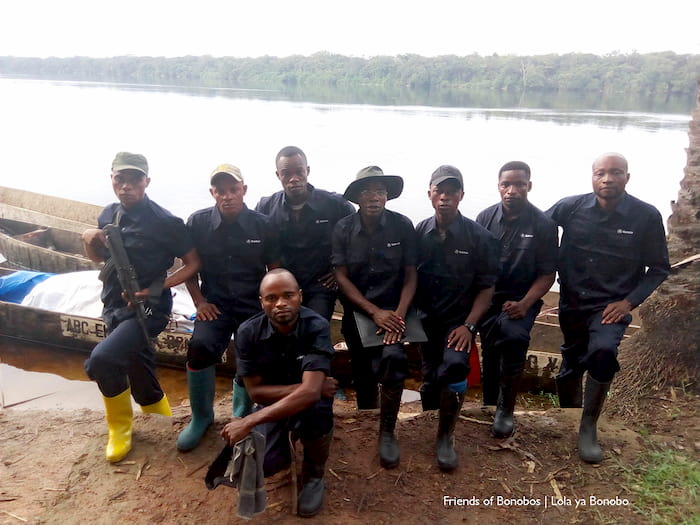
ICCN eco-guard team at Elonda. Photo: Lola ya Bonobo
These opportunities not only provide sources of employment, but also encourage local people to become invested in bonobo conservation. Recently, our bonobo release site, Ekolo ya Bonobo, was promoted into a community forest reserve, meaning that it is now under a partnership with the local communities. Together, we work to manage the reserve in a way that both benefits people while also continuing to protect bonobos.
8. What education programmes do you run? How have these been successful?
One of our biggest educational tools is the Lola ya Bonobo sanctuary itself. Each year, thousands of schoolchildren tour the sanctuary and learn about bonobos and reasons to conserve them. They also have the opportunity to view a living bonobo in a natural environment – something many of them have never been able to do. Just being able to see a bonobo is in itself a powerful thing that helps children form a deeper connection with conservation. We also host “Kindness Clubs” and other educational programs in local schools around Kinshasa to bring conservation to the classroom.
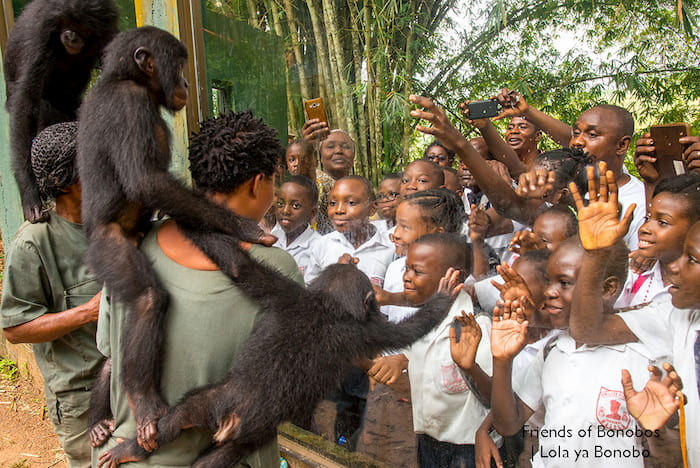
School children on a tour of the sanctuary. Photo: Lola ya Bonobo
Our educational work extends beyond Kinshasa and the sanctuary and into the rainforest areas where bonobos are heavily trafficked. We host all kinds of awareness activities deep in the heart of the rainforest, in the classroom but also in the general population. We even have pedal-powered film projectors so we can show videos about conservation in the most remote parts of the DRC where there is no electricity. Since the initiation of our educational programs, studies have shown attitudes towards bonobos and conservation are steadily improving among children in the DRC, and more people are taking action to help us rescue them.
9. Lola ya Bonobo has made the world’s only two bonobo releases. Could you tell me a little more about the releases and how they were successful?
It takes years of planning leading up to the bonobo releases. First, we monitor the behavior of every bonobo at the sanctuary and note which individuals have the strongest relationships and are the most socially competent to determine who should be included in the release group. They begin their training to live in the wild while still living at Lola ya Bonobo sanctuary. The bonobos are then quarantined on Totaka Island where they receive minimal human interaction to prepare them for integration into the wild.
Once released into Ekolo ya Bonobo Community Reserve, the bonobos are monitored by our bonobo trackers to understand how they are adjusting to life in the wild. They are also protected by eco-guards who keep the release site safe against poachers. There are more than 30 bonobos living in the reserve and they’ve had at least five babies, a good sign of success.
10. Do you breed bonobos at the sanctuary? If not, do you ever plan to?
Although bonobos engage in sexual behaviour quite often, much of it is social, not reproductive. Bonobos can only have babies about every 5 years – it’s one of the reasons they are so endangered. While we do not have a breeding program in place, we also do not discourage the bonobos from reproducing since their numbers continue to dwindle in the wild. When a bonobo mom is expecting a baby, her health is monitored by our veterinary staff to ensure successful deliveries. At birth, baby bonobos get a thorough health check. Bonobos born at Lola ya Bonobo are eligible for release alongside their wild-born friends.
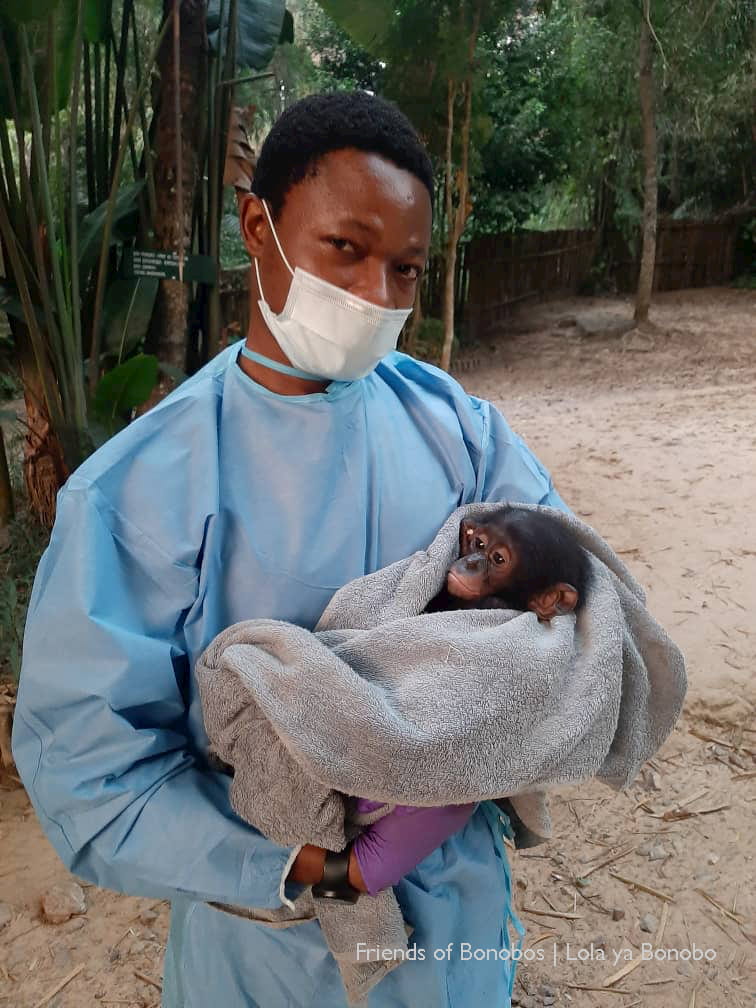
Dr. Jonas looking after baby Monkoto, one of the sanctuary’s new rescues. Photo: Lola ya Bonobo
11. With as little as 5,000 bonobos left in the wild, how long do we have to save the species?
We don’t really know. The size of the bonobo population in the wild is unknown. But we do know their populations are declining. They are under severe pressure because they are only found in the DRC and only south of the Congo River. Their habitat is being logged and opened up for agriculture. Their slow reproductive rate makes it hard for their numbers to even stay stable.
Some experts estimate we have just one lifetime, about 70 years, left to turn things around, or bonobos could become extinct…
12. How can people get involved with the sanctuary and make a positive difference?
The easiest and most effective way to support the work of Lola ya Bonobo is to make a donation. Gifts and grants pay for everything we do for bonobos, from feeding the bonobos at the sanctuary to transporting orphaned bonobos to paying our eco-guards to patrol and stop poaching.
You also can become a “Bonobo Champ” – donate your birthday or run your own fundraising event. You can also make a difference by raising awareness for bonobos. Share our stories on social media about the threats to our peace-loving cousins.
If you ever get the chance, visit the sanctuary! You can do a day tour or stay overnight at the eco-lodge (More info here.)
Lastly, to stay informed about bonobos, join our email list! Go to our website to sign up: www.lolayabonobo.org

